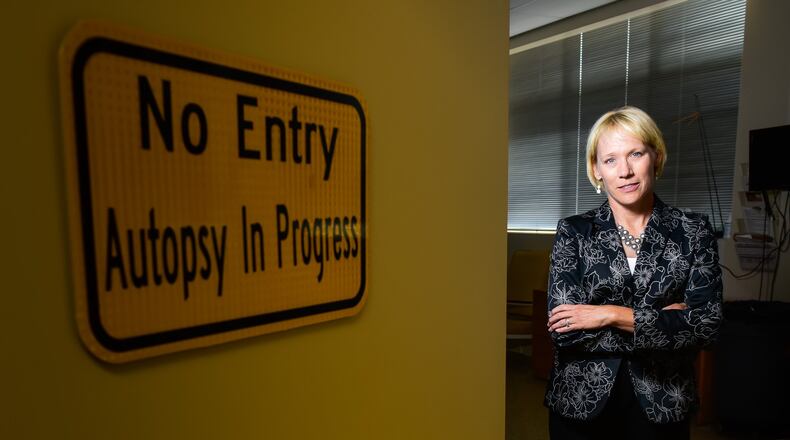Mannix said her morgue can hold 14 bodies, but the county as whole, including hospitals and funeral homes, only has 50 appropriate spaces. In a mass-casualty emergency, the county coroner is responsible for finding storage space for bodies before they can be buried.
“At the very beginning of the pandemic one of the questions that was asked of me was, where are you going to put all the dead bodies?,” Mannix said.
Early statewide predictions from the Ohio Department of Health were “in an unmitigated scenario of COVID-19 there could be 62,000 infections a day” which could have translated to 1,000 deaths per day, according to Mannix.
She said they went through a mass casualty planning process, and while the numbers didn’t materialize, it became apparent current capacity in inadequate. She is hoping the commissioners will give her a piece of the nearly $75 million the county received in federal American Rescue Plan funding to consolidate her operations and provide more space. A rough estimate from 2014 put the cost at $2.9 million for 10,000 square feet.
The county has been leasing warehouse space since 2003 for the morgue and almost since Mannix was elected in 2012, she has been seeking space that could house both the morgue and the coroner’s administrative offices. The morgue is located on Fairgrove Avenue in Hamilton and the coroner’s administrative offices are on the sixth floor of the Government Services Center — about a mile and a half away.
“Since that morgue has opened we’ve spent over $1 million in rent, over time that doesn’t seem like much, but if we invested that $1 million or we had that million to use for our own facility that would be helpful,” Mannix said. “Based on the pandemic and the main standards that we need better post-mortem specimen handling, environmental controls and obvious storage, I’ll keep harping on that storage.”
Mannix’s Administrator Martin Schneider told the Journal-News when they moved into the current morgue space the previous coroner estimated the space would be adequate for 20 to 25 years. The coroner had 332 cases in 2004 and has averaged 427 annually over the past five years.
Mannix has said many times she would be willing to share space with other county offices but everyone has joked no one probably wants to bunk with the morgue. She said she has toured other county buildings and “none of it has been suitable or the sheriff has claimed the space we’ve looked at so we don’t have any budget proposals to refit something.”
The county is embarking on a space utilization study and Commissioner Don Dixon told the Journal-News the coroner’s situation will be part of that examination. There is about $15 million penciled in the 2022 budget and some of that money could be used to fund recommendations from the study.
The county Developmental Disabilities Board is vacating the former adult day center on Liberty Fairfield Road in Liberty Twp. and several county officials have their eye on the 30,720-square-foot facility. Dixon said they could consider putting both the coroner and a relocated sheriff’s dispatch center in the building noting “I think they’d be fine” as neighbors in the building “they’re kind of compatible.”
The commissioners haven’t made any decisions on the federal rescue funds yet, they were concentrating on the spending plan for next year. Dixon said they will address the morgue situation “sooner rather than later.”
“I think all three of us are sympathetic to the need to put those together, we didn’t decide to separate them, a previous board of commissioners did that when this building was built,” Commissioner Cindy Carpenter told Mannix. “And we can solve the problem.”
About the Author

